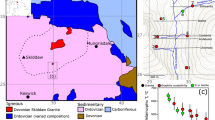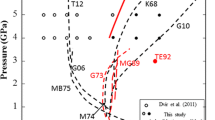Abstract
The Ballachulish Igneous Complex consists of an outer quartz diorite and an inner granite, emplaced at about 300 MPa, initially at 1000 to 1050 °C. The contact aureole (0.5–2 km wide) occurs in metapelites and metapsammites plus minor graphitic slates, carbonate rocks and metaquartzites. A textural examination of the arkosic Appin Quartzite, which was previously believed to have melted only within a few metres of the intrusion, demonstrates that partial melting occurred up to 500 m away from the vertical eastern contact. Coupling petrographic observations with Qtz-Ab-Or-H2O phase relations, we determined both the amounts of actual melt and the maximum possible amounts of melt in the samples. Melting efficiency was everywhere less than 100% and decreased with distance from the intrusion. Though perhaps not the only possible source of fluid throughout the aureole, simple models demonstrate that H2O evolution from the pluton would have been volumetrically sufficient and persisted long enough to account for the observed partial melting. A time-integrated fluid flux of 7000 kg/m2 from the pluton is necessary to account for the observed amounts of partial melt in the Appin Quartzite. From its inefficiency, we infer that infiltration of the Appin Quartzite cannot have occurred along interconnected grain-edge channels. Rather, it was controlled by hydraulic fracturing, with fracture density determining melting efficiency. Bulk-rock permeability is calculated to be 10−20 m2, an order of magnitude lower than that necessary to permit pervasive flow of all the fluid exsolving from the pluton. There is little difference between the calculated time-integrated fluid flux through the Appin Quartzite on the eastern flank and an estimate of the infiltrating flux through the pelitic Leven Schist on the western flank in the time interval during which both rock types were above their solidus temperature, despite differences in their equilibrium quartz-H2O dihedral angles at temperatures immediately below the solidus, and differences in the attitude of the contact. The rates of H2O expulsion from the cooling pluton are consistent with highly efficient fracture-dominated flow, allowing insufficient time for textural equilibration.
Similar content being viewed by others
Author information
Authors and Affiliations
Additional information
Received: 26 March 1998 / Accepted: 8 March 1999
Rights and permissions
About this article
Cite this article
Holness, M., Clemens, J. Partial melting of the Appin Quartzite driven by fracture-controlled H2O infiltration in the aureole of the Ballachulish Igneous Complex, Scottish Highlands. Contrib Mineral Petrol 136, 154–168 (1999). https://doi.org/10.1007/s004100050529
Issue Date:
DOI: https://doi.org/10.1007/s004100050529




